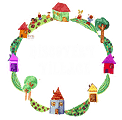In the days and weeks following the end of World War II, the area of Reggio Emilia in Northern Italy was left in ruins. The combination of military action against resistance to the Nazis and allied bombings had devastated the region. Amidst the rubble, on land contributed by a local farmer, using materials from bombed-out buildings, a small group of parents set out to build a preschool for their children. Funding came from the sale of an abandoned tank, three trucks, and a few horses remaining from the war. The parents, having just emerged from the horrors of World War II, envisioned a school that would prepare their children to stand strong against oppression, injustice, and inequality.
Having heard rumors of the preschool being built out of the rubble, a young educator named Loris Malaguzzi, himself strongly shaped by growing up under fascist rule, set out on his bicyle to see what was happening. Inspired, he commited the rest of his life to working with families in the region to create a school, then several schools, then a municipal network of schools, and over the years an international network of schools.
Core to the Reggio approach is the belief that children form their personalities during their early years and possess “a hundred languages”, or a multitude of ways to express their personalities, ideas, feelings, and creativity. These “languages” include painting, storytelling, movement, dramatic play, and so much more. Teachers work with children to plan both long and short term projects based on children’s interests. They document children’s activities and work, using photos, videos, audio, and written descriptions. This documentation is used to reflect on children’s learning, and to plan ongoing learning experiences. Nurturing strong relationships between children and their teachers as well as their peers is central to the approach. Respect, responsibility, and community are highly valued.
Reggio-Inspired
Schools adopting the Reggio philosophy typically call themselves “Reggio-inspired”. While embracing core principles of the Reggio approach, each Reggio school designs its own program reflecting the interests of children, educators, and families at the school. There is no one “Reggio Way”, no certification process to become a Reggio school, nor any particular curriculum that must be followed. Such standardization would be antithetical to the Reggio approach, which embraces exploration, creativity, and discovery based on children’s interests.
The Reggio Approach at Discovery Village
Offering our own unique flair to a Reggio-inspired approach, Discovery Village’s name speaks to our three core pillars: Relationships, Experiences, and Values (REV – REV it up with Discovery Village!) With the warmth of a close village, we focus on developing caring, trusting relationships. Experiences are viewed as the key to learning and creating with a robust project based approach. Children and teachers transform their classrooms into places that could exist in our village, stemming from children’s interests. Learning in all subject areas is carefully integrated into the experience of designing and living in these village places. Inspired by the vision of the founding families of the first Reggio school, who focused on preparing children to oppose oppression, injustice, and inequality, we embed an emphasis on living out core values within our village.
Key principles of Discovery Villages Reggio-inspired approach include:
Student Interest: Our curriculum emerges directly from student interest. We integrate learning experiences into the design of our village places and into activities children engage in within these places.
Self Expression and Creativity: We embrace the Reggio notion of “100 languages” or the many ways children can express their ideas, feelings, and creativity. These include painting, storytelling, theater, sculpting, music, science, math, dancing, and so much more.
The Physical Environment as a Teacher: Our classrooms are quite literally transformed again and again into places of interest to our children.
The Flexible Use of Time: Village places shift with student interest. They can last for as short a time as a week. Alternatively, as students become more deeply engaged and invested in a place, they can remain much longer.
Documentation and Sharing: Student work is documented in a range of media. This enables teachers, and children themselves, to reflect on learning. It also enables children to share their work with others. Children will publish their learning in our Village Magazine. They will also present to family and community members at Village Festivals, celebrations featuring what children have designed and learned in our village spaces.
We look forward to documenting our journey in designing and redesigning our village.

